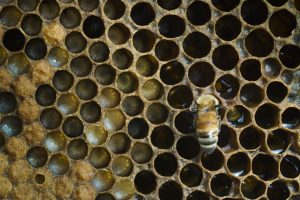We study the biotic interactions between the ectoparasitic Varroa mite and its honey bee host. Varroa is regarded by many scientists and beekeepers one of the most important causes of the honey bee health crisis. By studying the immune response and chemical signaling of infected brood we hope to develop approaches and tools for maintaining honey bee health in a sustainable, environmentally friendly way. Currently, we are focusing specifically on signals to induce hygienic behavior to help selective breeding of more hygienic bee stocks and potential incorporation into IPM practices. Strengthening the natural defenses of honey bees, such as hygienic behavior, has many benefits and can be sustainable, as exemplified by the coexistence of Varroa with its natural host the Eastern Honey Bee, Apis cerana.



Examples:
Wagoner K.M. & Rueppell O. “Methods and Compositions for Inducing Hygienic Behavior in Honey Bees.” US Patent Application 15/742072, filing date: 2018/01/05, publication date: 2018/06/28. Divisional application #16/279432, issue date Dec 24 2019.
Wagoner K.M., Spivak M., Hefetz A., Reams T., Rueppell O. (2019) Varroa mites and Deformed Wing Virus elicit hygienic behavior in honey bees through stock-specific changes in brood cuticular hydrocarbons. Scientific Reports, 9: 8753.
Wagoner K.M., Spivak M., Rueppell O. (2018) Brood affects hygienic behavior in the honey bee (Hymenoptera: Apidae). Journal of Economic Entomology, 111(6): 2520-2530.
Kuster R.D., Boncristiani H.F., Rueppell O. (2014) Immunogene and viral transcript dynamics during parasitic Varroa destructor (Anderson) mite infection of developing honey bee (Apis mellifera L) pupae. Journal of Experimental Biology, 217: 1710-1718.
Rueppell O., Hayes A.M., Warrit N., Smith D.R. (2011) Population structure of Apis cerana in Thailand reflects biogeography and current gene flow rather than Varroa mite association. Insectes Sociaux, 58: 445-452.